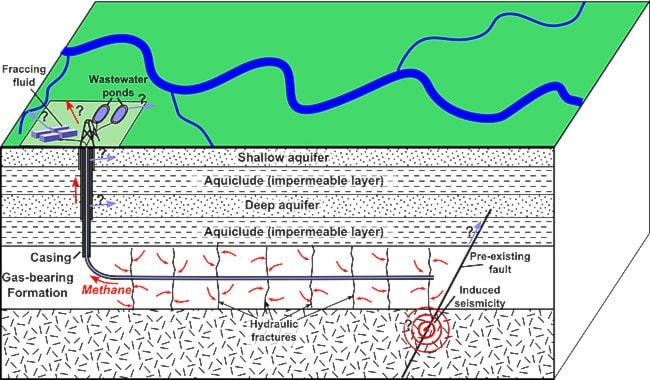The Yukon government is striking an all-party committee to review the risks and benefits of hydraulic fracturing before it is allowed in the territory.
The controversial technique of extracting natural gas involves pumping a slurry of water, sand and chemicals into wells deep underground. It is commonly known as fracking.
The committee’s creation is a compromise for the NDP Opposition, who has called for a full public consultation and rigorous scientific review of the practice.
The NDP has also charged that the government has already made up its mind on fracking. It notes that Premier Darrell Pasloski has been bullish about the prospects of building a local natural gas industry.
“Apache Resources has reported the discovery of one of the largest shale gas deposits in the world - approximately 48 trillion cubic feet in the Liard Basin that straddles the Yukon-B.C. border,” Pasloski said in his budget speech in March.
Natural gas trapped in shale rock typically requires fracking to extract.
There are two promising regions for natural gas development in the Yukon. The southwest Yukon, where the Liard Basin is, and Eagle Plain in the north.
The work of Apache Corporation in B.C. is interesting here in the Yukon for two reasons.
First, as the premier has noted more than once, the company boasts of an incredible deposit of natural gas in the Liard Basin. On its website, Apache calls it the “best unconventional gas reservoir in North America.”
Unconventional drilling means using new technologies to get at previously hard-to-reach resources. In the vast majority of cases, unconventional drilling means fracking.
Unconventional drilling now accounts for most of the natural gas produced in B.C.
Second, Apache has partnered with Chevron Corporation on a project to build a liquefied natural gas plant in Kitimat, B.C., so that North American natural gas can be shipped to Asian markets.
Natural gas prices here have been depressed by the abundant supply of fracked gas, but overseas, gas sells for many times as much.
The Kitimat LNG plant could be a route out for Yukon natural gas, if the industry is developed.
The only oil and gas company currently operating in southeast Yukon is EFL Overseas Inc., which recently bought a controlling interest in Yukon’s only two producing natural gas wells in the Kotaneelee gas field, within the Liard Basin.
So far the company has stayed mostly quiet about its plans, but in press releases it has boasted of the area’s “conventional and important unconventional resource development opportunities.”
To the north, Northern Cross’s project in Eagle Plain is in many ways more developed.
The company caused a stir in August when it indicated that hydraulic fracturing could be part of its exploration plans for the region.
It dropped fracking from the proposal after the Yukon Environmental and Socio-economic Assessment Board asked the company for more information on the planned use of the technology.
Northern Yukon is at the disadvantage of being far from existing pipelines to get natural gas to markets. However, it has the distinct advantage of not being in Kaska traditional territory.
Yukon’s unsigned Kaska First Nations claim a vast swath of southeast Yukon as their traditional territory.
Until late last year, the Kaska had veto power over any oil and gas development in that area. Then, after years of failed negotiations, the government removed the consent clause from the Oil and Gas Act.
The Liard First Nation and Ross River Dena Council maintain that their right to a veto still exists under various agreements with the government, and they have indicated that they will oppose all fracking in the territory.
Developing a large natural gas industry in the Yukon could still be a long way away. And while unconventional resources are vastly more plentiful, conventional resources are easier to get at and likely to be accessed first.
And with low market prices, at least for now, the industry is not yet banging on the territory’s door.
If the domestic price for natural gas should increase significantly, there could be a push for the industry to expand into the Yukon, according to Doug Matthews, an energy consultant based in Alberta.
But increasing prices would also make well-developed shale resources more viable, and increase supply from the south as well.
The Yukon government wants a healthy natural gas industry both as a means for economic development and as cheap source of energy.
Yukon Energy plans to shift some of the territory’s back-up energy supply from diesel to natural gas over the next couple years.
Initially, the gas will have to be trucked up from the south in its liquefied form. But if a local market becomes available, it will be an even cheaper proposition.
The committee announced by the government last week will be charged with reviewing the potential risks and benefits of fracking before any permits are granted for the activity to take place in the Yukon.
It will be composed of the Yukon Party’s Patti McLeod, Currie Dixon and Stacey Hassard, the NDP’s Jim Tredger, The Liberals’ Sandy Silver and Independent Darius Elias.
McLeod will chair the committee.
Its task will be to consult with Yukoners and interest groups and come up with a series of recommendations to present to the legislative assembly.
The goal will be to reach consensus, and where consensus is not reached it will be noted in the recommendations, said Dixon.
Contact Jacqueline Ronson at
jronson@yukon-news.com
